
Wine Culture and Information since 2002 - Volume 22
 Wine Culture and Information since 2002 - Volume 22 |
|
Issue 131, Summer 2014 |
Contents |
|
|
Fads and Fears of Wine |
|
I am into wine for more than twenty years now, focusing my interest - in particular - to historical, technical, productive, territorial and sensorial aspects. In all of this time I had the chance to see - sometimes in a very funny way, sometimes quite perplexed - to the many facts which characterized the fate of wine. Twenty years, or a little more, can seem to be a lot, indeed they are passed with a surprising speed, just like all the many fads and fears which characterized the world of wine. Many of them have been a sort of meteors, others evidently had a quite long life, however destined to an unavoidable decline, sometimes even consigned to oblivion. Because of my predilection for technical aspects, it is quite unavoidable to me not considering fads and fears of wine according to this point of view. Most of the times they sound like ridiculous truth unfolded to the world with the evident goal of supporting personal and commercial interest of some or to just revealing the ignorance of others. Like all the subjects being of interest for a remarkable number of persons, opinions, ideas, remarks and fads happens frantically and, sometimes, chaotically. Wine is no exception to this phenomenon, of course. In about twenty years - despite this is a quite short time - I personally witnessed many fads and trends about wine. When I started being into the nectar of Bacchus, saved in rare exceptions, when you were talking about quality wine, you unavoidably ended up talking about French wine, by considering it a sort of impossible dream. The rest, including Italy, was irremediably behind: you were talking about it but your dreams would however fly to the magic places of France, in particular Bordeaux, Burgundy and Champagne. It was a time in which Italy was trying to recover from the wounds of the so called “methanol scandal”, wine production was abundant; juts like today the choice was wide and diversified. Of course, wineries which have always seen in wine a quality product with no compromises, continued to keep the good name of Italy all over the world. The interest for France and its undeniably quality wines, introduced everywhere in the world the fad of barrique, Merlot and Chardonnay, just to mention the three most famous examples. It seemed the secret of quality could be obtained with these three simple elements only. A wine produced with Merlot and fermented or aged in barrique meant - most of the times - the indisputable consecration to the Olympus of Bacchus. The same happened with Chardonnay, of course. Moreover, the humble Italian grapes, despite they had centuries of glorious history - at those times considered rough and vulgar - rose to nobility thanks to the marriage to Merlot and Chardonnay. The added value of the barrique meant apotheosis. Today, just by mentioning Merlot, Chardonnay and barrique - even inadvertently or by chance - causes to most of wine lovers a sneer of disapproval. Expert wine lover - or supposed ones - are even capable of hurling a curse at you and to propose you to excommunication, or even sending you to a saving quarantine in order to get a proper wine reeducation. How times change. There also were wines, in particular white wines, having pretty common aromas and universally considered agreeable: sometimes certain grapes generally classified as “non aromatic”, had charming aromas of grape and tropical fruit. They were liked by everyone, everyone was looking for them. Magic of selected yeast, many will say, or - in practical terms - result of research and studies, years spent in understanding there are positive yeasts for wine making and others less positive ones. Fermentation done with indigenous yeast? It was a peasant practice, of rough and vulgar wines. Today selected yeast is rejected while spontaneous fermentation is celebrated everywhere, the one done with a yeast chance and Nature have brought to grape skins or inside a winery. Selected yeast? It is the alchemist business, nasty and vulgar sorcerers. Aromas change but, in practical terms, the result is the very same. If it is true selected yeast characterizes the sensorial profile of a wine, the very same happens with indigenous yeast. Yeast, no matter of its origin, always gives the wine its personality, with no exception. When the fear for selected yeast passed, it arrived - strong and alarming - the fear for sulfur dioxide. Let's make this clear: this gas, when assumed in high quantity, causes health disorders, in particular in sensitive subjects. In this regard, it is obvious a wine to be the least harmful possible for health is something interesting every wine lover. The use of sulfur dioxide in wine making is as old as the history of wine itself. Its antioxidant and antiseptic qualities are known to everyone, also and above all to the food industry. This is a job it can do very well and, moreover, at a very low cost. We pay attention about drinking a wine having the least possible quantity of sulfites, but we do not have the same concern when we consume most of food and beverages containing a lot more than what the law permits in wine. We should then notice fermentation always and with no exception produces sulfur dioxide and, sometimes, certain natural yeasts produce more than what selected yeasts do. After all, selected yeast was introduced also for the purpose of limiting sulfur dioxide production during fermentation. Nevertheless, today, both are considered as elements of adulteration and of deplorable wine making standardization. Talking about harmful substances found in wine, or potentially such, I have rarely seen shouting floods of words - in a way they do or did for sulfites, selected yeast and other - for what is notoriously considered a toxic substance: ethyl alcohol. In the last twenty years we have seen a progressive increasing of ethyl alcohol in wines and not so many have complained about this or fought any crusade like they did - fiercely and sometimes hypocritically - for other aspects about wine. Twenty-five years ago a wine with 12.5% of alcohol by volume was considered “strong”; today we have wines reaching even 15% and are considered “normal”. Nevertheless, ethyl alcohol has non properly positive effects on health and the excess - just like sulfur dioxide - can even cause death. Towards ethyl alcohol, it is too obvious, there is a higher tolerance and acceptability than sulfur dioxide and selected yeast. Wine, just like every other thing, in order to keep the interest high and to make profits, must live of fads and fears which born, explode in furious debates, then fade away and are forgotten by everyone. Sic transit gloria mundi. Antonello Biancalana
|
||||
Analogies of White and Rose WinesTwo different wine styles which sometimes show common sensorial characteristics. Different grapes and wine making techniques for wines which can sometimes taste the same. |
|
Comparing white and rose wines can sound like a nonsense. According to a wine making point of view, they certainly are two wine styles that, in general terms, do not have a lot in common, including grapes. White wines, in fact, are exclusively made from white berried grapes, whereas rose wines are produced with red berried grapes only. On this regard, we should notice, according to the wine laws in force in most of wine making countries in the world, production of rose wines by blending white and red wines is forbidden. The only wine style for which is allowed such blending is sparkling wine, as for rose wines it is sometimes allowed the production of the base wine by blending whites and reds. For the sake of completeness, this method is not always used for the production of sparkling wines: most of them are in fact made with real rose wines and uniquely made from red berried grapes. Grape types apart, the production of white and rose wines however have some wine making characteristics in common. Before discussing the sensorial analogies of the two styles, let's shortly discuss about their production. White wines are usually produced from white berried grapes and soon after crushing - an operation allowing the extraction of the juice from grape berries - skins are separated from the must. After any needed operation for the stabilization and “cleaning” of must, the alcoholic fermentation is started. This production method is called white wine making and it is also used in case of red berried grapes which must is immediately separated from skins. In this specific case, it should be noticed wine obtained with this method is always “white” also in case of red berried grapes. This is how are being made, for example, classic method sparkling wines called blanc de noirs, that is whites from red grapes. The production of white wines does not necessarily follow this wine making model. The technique, in fact, can in certain cases become more complex, however - in general terms - their production uses this procedure. Rose wines - like already said - are produced with red berried grapes and, soon after crushing, grape skins are allowed to macerate with must in order to extract color. We should in fact notice color of rose wines, just like in reds, comes from the coloring substances found in grape skins. Maceration time is one of the factors determining the color to be extracted from skins: the longer the time, the more the wine will get a red color. Moreover, we should also notice the coloring property of grapes is characteristic to each single variety, therefore the content of coloring substances, as well as time, determine the intensity of pink or red color. In grape skin is not found color only. This is in fact also the place where are found aromatic substances - variable for nature and intensity according to each single variety - a characteristic valid, in particular, for white berried grapes. Maceration of skins in must, besides extracting color and polyphenolic substances, also enriches grape juice with aromas. If it is true the extraction of polyphenolic substances from skin in red and rose wines is a wanted factor, in whites this is sometimes improper and unwanted. The extraction of polyphenols is generally avoided in the production of white wines, however - it should be said - it is sometimes used in order to enrich the must of polyphenolic substances and to give a more intense color. During maceration, alcoholic fermentation usually starts and - because of the increasing of temperature and the progressive production of alcohol - it favors the extraction of both color and polyphenolic substances.
For this reason - and in general terms - the must of white wines allowed to macerate with skins in order to extract aromatic substances, is kept to a low temperature in order to prevent the start of fermentation. The maceration of the skin in the must usually lasts few hours and it hardly goes beyond one full day. At the end of maceration, both in white and in rose wines, the must is separated from the skins and it is then started the fermentation, which is also sometimes started during maceration. For certain white wines in which this technique is used, fermentation is started during the maceration with skins and, in some case, they are separated at the end of this phase. The same is not done for rose wines, as the maceration does not generally go beyond twenty-four hours and fermentation is never completely ended with skins. The production of white and rose wine, considered according these techniques, shows evident analogies, as skins play a role in both cases. It should be said wine production providing for the maceration of skins in the fermentation process is called red wine making also in case of white wines. In this specific case, wine is defined as a white vinified in red although it does not get this color at all. At the end of fermentation, a white wine vinified with skins, will have an evidently more intense and deeper color than the same wine separated from skin soon after crushing. The long maceration of white wines with skins determines, in every case and like we will see later, substantial sensorial characteristics, from appearance to taste. The same thing happens, of course, also in rose wines: the duration of maceration with skins affects its sensorial qualities. The analogies of white and rose wines are af course limited: different colors, yellow the former, pink the latter. The only real analogy of which we can talk is transparency. In both cases we can talk about wines having a moderate or high transparency; lower transparencies are however characteristics of certain red wines. In rose wines made from a very short maceration with skins - usually six hours - the color can be extremely pale, in particular in those made from red grapes with a low coloring property. In these cases, when observing nuances of color - done by properly tilting the glass - it can sometimes be noticed yellow or orange nuances. After all, a rose wine is a “white” must variably colored of pink, with different hues and intensity. In case of short maceration, the “white” nature of the must becomes evident. The aromatic profiles of the two wine styles are clearly characterized by a higher number of analogies, despite the preliminary evaluation of their aromas is clearly characterized by substantial differences. In general terms, in white wines are mainly perceived aromas of white and yellow flowers as well as white and yellow fruits. In rose wines, the main perceptions are about red and pink flowers as well as red fruits, rarely, black fruits. In general terms, the typical aromatic qualities of rose wines are not perceived in white wines, except in rare cases and in wines produced with particular techniques. The opposite can frequently happen instead. This means in rose wines can be normal to perceive, besides the characteristic aromas for this style, many of the olfactory sensations found in whites. The main olfactory analogies common to whites and roses are classified in the aromatic families of flowers and fruits. Among the main typical aromas of white wines and sometimes perceptible in roses are mentioned: hawthorn, jasmine and lavender. The sensations of fruit are clearly richer, sometimes even recalling tropical fruits. Peach, plum, pear, apple, banana, kiwi, apricot and medlar - just to give an example - are in fact also perceptible in rose wines. It is, however, about sensations generally perceived as “secondary” for intensity when compared to the typical aromas of rose wines, although it should be noticed - in certain cases - these aromas can be quite intense. Another olfactory analogy that, sometimes, can be perceived both in roses and, more frequently, in whites, is the almond aroma, in particular in certain rose wines produced in South Italy. Olfactory analogies can be even more in case of wines fermented or aged in cask. This technique is rarely used for rose wines, as in most of the cases it is wished to vinify them in inert container in order to enhance and keep fruit and flower aromas. There are however exceptions in which rose wines are being aged, or even fermented, in cask. Of course, both in whites and roses, the perception of aromas given by wood to wine becomes evident and determinant in function of the duration of the aging in wood. In this case, we cannot exactly talk about analogies of the two styles of wine: indeed it is a productive analogy, something which can be found in any style, including red wines. The analogy of white and rose wines can also be perceived to the taste. Crispness - a sensorial concept associated to acidity - is a typical characteristic in whites and it is very common in roses as well. The intensity of acidity in rose wines can sensorially reach the one of whites, a fundamental quality for their balance. The intensity of crispness is of course in function of the grape variety, however it should be noticed rose wines are more agreeable in case they are produced with grapes having a significant content of acidic substances. Acidity in rose wines is in fact useful and essential for the balance of alcohol and any possible residual sugar. For this reason, rose wines are usually served at a pretty cool temperature - around 12 °C (54 °F) - in order to emphasize their crisp character. Also roundness is very similar to the one of white wines, that is pretty low, at least in case they are produced in inert containers, such as steel or cement tanks. Fermentation or aging in wood gives both roundness and astringency, because of the passing of tannins in wine. Astringency is also determined by the duration of maceration in skins, characteristic which is also in function of each grape variety. Fermentation and aging in wood give a slight astringency to white wines as well and, just like in rose wines, it can be accentuated by the maceration in skins. Fermentation and aging in wood, as well as maceration in skins, also contribute to increasing the structure in both wine styles, by making them, sometimes, even robust.
|
||||||||||||
Wines of the Month |
|
|
|
Score legend Prices are to be considered as indicative. Prices may vary according to the country or the shop where wines are bought |
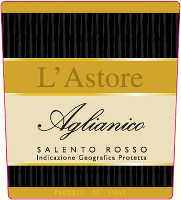
|
|
L'Astore 2009 |
|
| L'Astore Masseria (Apulia, Italy) | |
| Grapes: Aglianico | |
| Price: € 14.00 | Score: |
| L'Astore shows a brilliant ruby red color and nuances of garnet red, little transparency. The nose denotes intense, clean, pleasing and refined aromas which start with hints of blackberry, plum and black cherry followed by aromas of violet, blueberry, vanilla, chocolate, tobacco and carob. The mouth has good correspondence to the nose, a properly tannic attack and however balanced by alcohol, good body, intense flavors, agreeable. The finish is persistent with flavors of black cherry, blackberry and plum. L'Astore ages for 14 months in barrique. | |
| Food Match: Broiled meat and barbecue, Stewed meat with mushrooms, Hard cheese | |
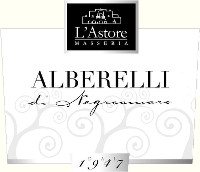
|
|
Alberelli 2008 |
|
| L'Astore Masseria (Apulia, Italy) | |
| Grapes: Negroamaro | |
| Price: € 21.50 | Score: |
| Alberelli shows an intense ruby red color and nuances of garnet red, little transparency. The nose denotes intense, clean, pleasing, refined and elegant aromas which start with hints of plum, blackberry and black cherry followed by aromas of dried violet, blueberry, carob, tobacco, vanilla, chocolate, licorice, leather and menthol. The mouth has good correspondence to the nose, a properly tannic attack and however balanced by alcohol, good body, intense flavors, pleasing roundness. The finish is persistent with flavors of plum, blackberry and black cherry. Alberelli ages in cask for 30 months. | |
| Food Match: Broiled meat and barbecue, Stewed meat, Roasted meat, Hard cheese | |
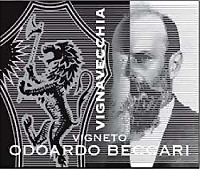
|
|
Chianti Classico Riserva Odorardo Beccari 2010 |
|
| Fattoria Vignavecchia (Tuscany, Italy) | |
| Grapes: Sangiovese (90%), Canaiolo Nero (10%) | |
| Price: € 21.00 | Score: |
| Chianti Classico Riserva Odorardo Beccari shows a brilliant ruby red color and nuances of ruby red, moderate transparency. The nose denotes intense, clean, pleasing and refined aromas which start with hints of black cherry, plum and raspberry followed by aromas of violet, blueberry, blackberry, cyclamen, vanilla, chocolate and cinnamon. The mouth has good correspondence to the nose, a properly tannic attack and however balanced by alcohol, good body, intense flavors, pleasing crispness. The finish is persistent with flavors of black cherry, plum and raspberry. Chianti Classico Riserva Odorardo Beccari ages for 18 months in barrique followed by 6 months of aging in bottle. | |
| Food Match: Broiled meat, Roasted meat, Stewed meat with mushrooms, Hard cheese | |

|
|
Vin Santo del Chianti Classico 2005 |
|
| Fattoria Vignavecchia (Tuscany, Italy) | |
| Grapes: Malvasia Bianca | |
| Price: € 28.00 - 375ml | Score: |
| This Vin Santo del Chianti Classico shows a deep amber yellow color and nuances of amber yellow, moderate transparency. The nose reveals intense, clean, pleasing and refined aromas that start with hints of raisin, dried fig and caramel followed by aromas of honey, date, plum jam, walnut, citrus fruit peel, vanilla, almond and nail polish. The mouth has good correspondence to the nose, a sweet and round attack, however balanced by alcohol, good body, intense flavors, pleasing crispness. The finish is persistent with flavors of raisin, dried fig and caramel. This Vin Santo del Chianti Classico ferments and ages for 5 years in small oak barrels. | |
| Food Match: Jam and dried fruit tarts, Hard cheese | |
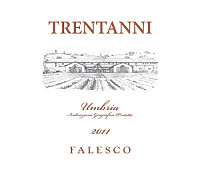
|
|
Trentanni 2011 |
|
| Falesco (Umbria, Italy) | |
| Grapes: Sangiovese (50%), Merlot (50%) | |
| Price: € 20.00 | Score: |
| Trentanni shows an intense ruby red color and nuances of garnet red, little transparency. The nose denotes intense, clean, pleasing and refined aromas which start with hints of black cherry, black currant and plum followed by aromas of blueberry, violet, vanilla, tobacco, chocolate, mace and eucalyptus. The mouth has good correspondence to the nose, a properly tannic attack and however balanced by alcohol, good body, intense flavors, agreeable. The finish is persistent with flavors of black cherry, black currant and plum. Trentanni ages for 12 months in barrique. | |
| Food Match: Broiled meat and barbecue, Roasted meat, Stewed meat, Hard cheese | |
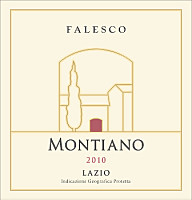
|
|
Montiano 2011 |
|
| Falesco (Umbria, Italy) | |
| Grapes: Merlot | |
| Price: € 35.00 | Score: |
| Montiano shows an intense ruby red color and nuances of ruby red, little transparency. The nose reveals intense, clean, pleasing, refined and elegant aromas which start with hints of black currant, black cherry and plum followed by aromas of blueberry, violet, vanilla, tobacco, pink pepper, chocolate, mace and eucalyptus. The mouth has good correspondence to the nose, a properly tannic attack and however balanced by alcohol, full body, intense flavors, pleasing roundness. The finish is persistent with flavors of black currant, black cherry and plum. Montiano ages for 12 months in barrique. | |
| Food Match: Game, Roasted meat, Braised and stewed meat, Hard cheese | |

|
|
Morellino di Scansano Riserva 2011 |
|
| Moris Farms (Tuscany, Italy) | |
| Grapes: Sangiovese (90%), Cabernet Sauvignon, Merlot (10%) | |
| Price: € 19.50 | Score: |
| This Morellino di Scansano Riserva shows an intense ruby red color and nuances of garnet red, little transparency. The nose denotes intense, clean, pleasing and refined aromas which start with hints of black cherry, plum and blueberry followed by aromas of violet, blackberry, geranium, chocolate, vanilla, mace and menthol. The mouth has good correspondence to the nose, a properly tannic attack and however balanced by alcohol, good body, intense flavors, agreeable. The finish is persistent with flavors of black cherry, blueberry and plum. This Morellino di Scansano Riserva ages for 12 months in barrique followed by 6 months of aging in bottle. | |
| Food Match: Broiled meat and barbecue, Roasted meat, Stewed and braised meat, Hard cheese | |
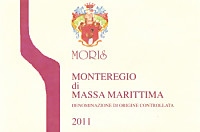
|
|
Monteregio di Massa Marittima Rosso 2011 |
|
| Moris Farms (Tuscany, Italy) | |
| Grapes: Sangiovese (90%), Cabernet Sauvignon (10%) | |
| Price: € 12.50 | Score: |
| Monteregio di Massa Marittima Rosso shows an intense ruby red color and nuances of ruby red, little transparency. The nose denotes intense, clean, pleasing and refined aromas which start with hints of black cherry, plum and black currant followed by aromas of violet, blueberry, blackberry, vanilla, tobacco, chocolate and menthol. The mouth has good correspondence to the nose, a properly tannic attack and however balanced by alcohol, good body, intense flavors, agreeable. The finish is persistent with flavors of black cherry, plum and black currant. Monteregio di Massa Marittima Rosso ages for 12 months in barrique. | |
| Food Match: Roasted meat, Stewed and braised meat with mushrooms, Hard cheese | |
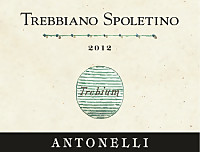
|
|
Trebbiano Spoletino 2012 |
|
| Antonelli San Marco (Umbria, Italy) | |
| Grapes: Trebbiano Spoletino | |
| Price: € 11.00 | Score: |
| This Trebbiano Spoletino shows an intense straw yellow color and nuances of straw yellow, very transparent. The nose denotes intense, clean, pleasing and refined aromas that start with hints of apple, citrus fruits and plum followed by aromas of pear, peach, broom, medlar, hawthorn, mineral and hints of vanilla. The mouth has good correspondence to the nose, a crisp attack and however balanced by alcohol, good body, intense flavors, pleasing roundness. The finish is persistent with flavors of apple, plum and medlar. This Trebbiano Spoletino ferments and ages in cask for 9 months followed by 3 months of aging in bottle. | |
| Food Match: Cold cuts, Pasta with meat, Roasted fish, Sauteed white meat | |
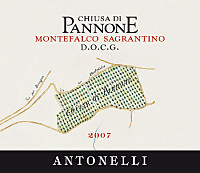
|
|
Montefalco Sagrantino Chiusa di Pannone 2007 |
|
| Antonelli San Marco (Umbria, Italy) | |
| Grapes: Sagrantino | |
| Price: € 35.00 | Score: |
| Montefalco Sagrantino Chiusa di Pannone shows an intense ruby red color and nuances of garnet red, little transparency. The nose reveals intense, clean, pleasing, refined and elegant aromas which start with hints of blackberry, plum and dried violet followed by aromas of black cherry, blueberry, vanilla, pink pepper, tobacco, dried rose, chocolate, licorice, mace, leather and menthol. The mouth has excellent correspondence to the nose, a tannic attack and however balanced by alcohol, full body, intense flavors, pleasing roundness. The finish is very persistent with long flavors of blackberry, plum and black cherry. Montefalco Sagrantino Chiusa di Pannone ages for 21 months in cask, 3 months in cement tanks and for 24 months in bottle. | |
| Food Match: Game, Roasted meat, Stewed and braised meat, Hard cheese | |
News |
|
In this section are published news and information about events concerning the world of wine and food. Whoever is interested in publishing this kind of information can send us a mail to our address.
|
AquavitaeReview of Grappa, Distillates and Brandy |
|
|
| Distillates are rated according to DiWineTaste's evaluation method. Please see score legend in the "Wines of the Month" section. |
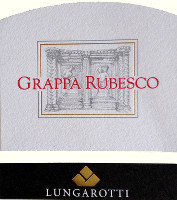
|
|
Grappa Rubesco |
|
| Lungarotti (Umbria, Italy) | |
| (Distiller: Distilleria Bonollo) | |
| Raw matter: Vinaccia di Sangiovese e Canaiolo Nero | |
| Price: € 17.00 - 50cl | Score: |
| Grappa Rubesco is limpid, colorless and crystalline. The nose denotes intense, clean and pleasing aromas of black cherry, violet, plum, raspberry and hazelnut, with perceptible alcohol pungency. In the mouth has intense flavors with perceptible alcohol pungency which tends to dissolve rapidly, good correspondence to the nose, pleasing roundness and sweetness. The finish is persistent with flavors of black cherry and raspberry. Grappa Rubesco is distilled in a steam batch distiller. | |
Wine Parade |
|
|
| The best 15 wines according to DiWineTaste's readers. To express your best three wines send us an E-mail or fill in the form available at our WEB site. |
| Rank | Wine, Producer | |
|---|---|---|
| 1 |
| Villa Gresti 2006, Tenuta San Leonardo |
| 2 |
| Amarone della Valpolicella Classico Capitel Monte Olmi 2007, Tedeschi |
| 3 |
| Langhe Riesling Herzu 2011, Ettore Germano |
| 4 |
| Brunello di Montalcino Vigna Loreto 2007, Mastrojanni |
| 5 |
| Sagrantino di Montefalco Collepiano 2007, Arnaldo Caprai |
| 6 |
| Brunello di Montalcino 2007, Donatella Cinelli Colombini |
| 7 |
| Pelago 2009, Umani Ronchi |
| 8 |
| Verdicchio dei Castelli di Jesi Classico Superiore Podium 2010, Garofoli |
| 9 |
| Maximo 2010, Umani Ronchi |
| 10 |
| Camartina 2008, Querciabella |
| 11 |
| Collio Ribolla Gialla L'Adelchi 2012, Venica |
| 12 |
| I Sodi di San Niccolò 2008, Castellare di Castellina |
| 13 |
| San Leonardo 2006, Tenuta San Leonardo |
| 14 |
| Adarmando 2011, Tabarrini |
| 15 |
| Trento Brut Riserva Methius 2006, Dorigati |
| |||||||
Privacy Policy | |||||||


| Copyright © 2002-2024 Antonello Biancalana, DiWineTaste - All rights reserved |
| All rights reserved under international copyright conventions. No part of this publication and of this WEB site may be
reproduced or utilized in any form or by any means, electronic or mechanical, without permission in writing from DiWineTaste. |